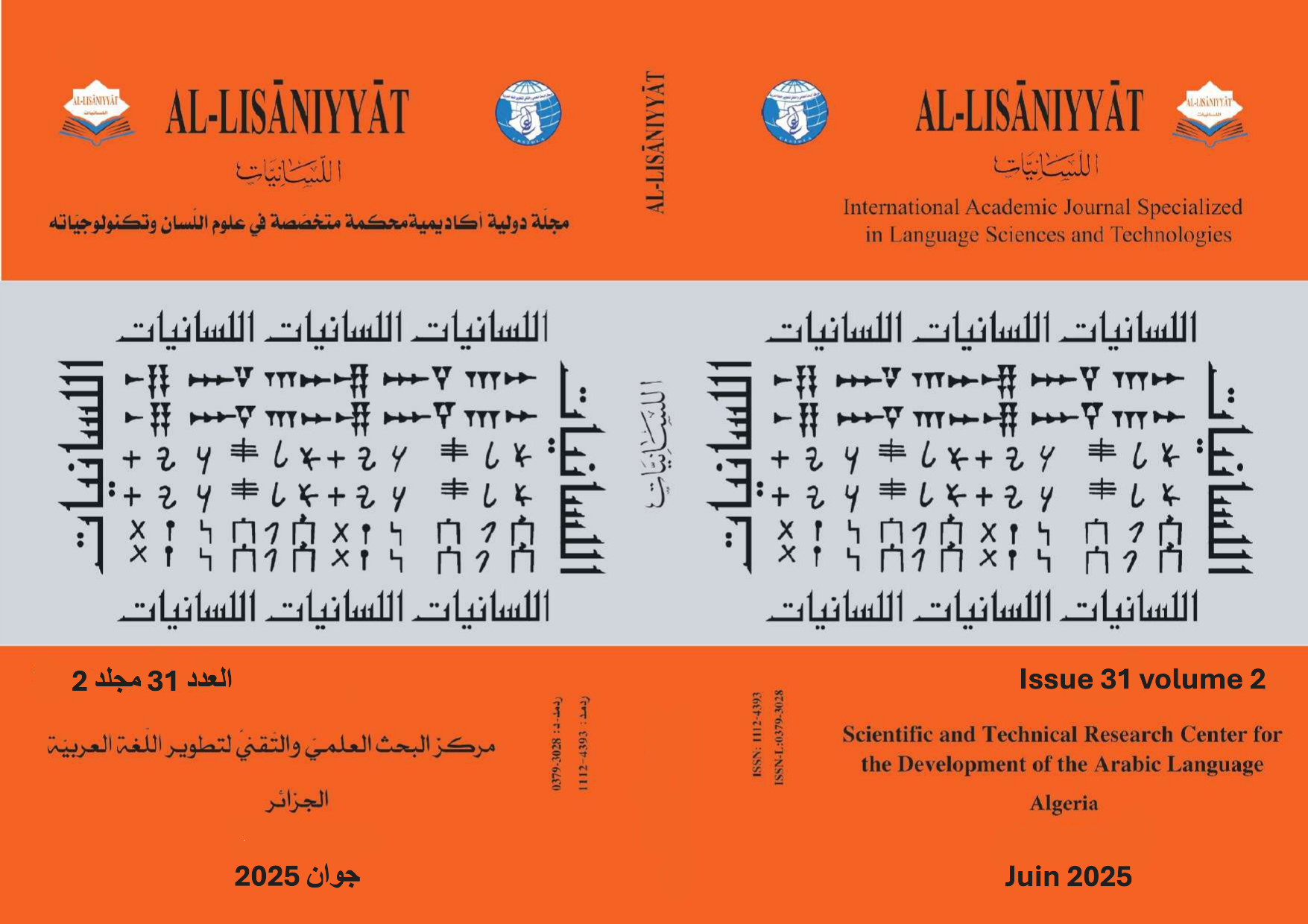Le Principe de Cohérence et son Impact sur la Lisibilité des Textes
##plugins.themes.bootstrap3.article.main##
Résumé
Cette étude vise à souligner que la lisibilité des textes (leur facilité de compréhension) est fondamentalement liée au principe de cohérence, lequel repose sur la relation dialectique entre le texte et le lecteur. En effet, «il n’existe pas de texte intrinsèquement cohérent ou intrinsèquement incohérent indépendamment du lecteur».
L’étude du principe de cohérence s’articule autour de deux composantes fondamentales du texte : les concepts et les relations qui les relient, ainsi que les liens de cohésion qui les unissent. « Les concepts et les relations forment ensemble la base sémantique du texte».
Cette base sémantique n’est pas un donné préétabli ; elle est construite par le lecteur à travers le processus de compréhension du texte, qui s’effectue par l’interaction entre ses connaissances préalables et les informations contenues dans le texte. Comme il est mentionné que «Le texte est lu par le lecteur… et le lecteur est l’égal du texte en termes de capacité productive et d’exigences cognitives», cela implique qu’un certain degré de compatibilité et de cohérence doit exister entre les concepts et les thèmes présentés dans le texte, qu’ils soient exprimés explicitement ou implicitement, et les connaissances antérieures du lecteur.
##plugins.themes.bootstrap3.article.details##

Ce travail est disponible sous licence Creative Commons Attribution - Pas d'Utilisation Commerciale 4.0 International.
Références
- بازي، محمد (2019). مبادئ أولية لمشروع قرائي متعدد الاستراتيجيات. المغرب: دار القلم العربي للنشر والتوزيع.
- البستاني، بشرى محمد (2011). في مفهوم النص ومعايير نصية القرآن الكريم. أبحاث كلية التربية الأساسية. 11 (1).
- بحيري، سعيد حسن (1997). علم لغة النص، المفاهيم والإجراءات. لبنان: مكتبة لبنان ناشرون.
- الزاكي، عبد القادر (2000). من النموذج النصي إلى النموذج التفاعلي. من كتاب جماعي: نظرية التلقي إشكالات وتطبيقات. الدار البيضاء، المغرب: منشورات كلية الآداب والعلوم الإنسانية.
- حسان، تمام. ( 1983 ). اللغة والنقد الأدبي. فصول. 1 (4).
- خطابي، محمد (2006). لسانيات النص، مدخل إلى انسجام الخطاب، الدار البيضاء، المغرب: المركز الثقافي العربي.
- فرج، حسام أحمد (2009). نظرية علم النص. القاهرة: مكتبة الآداب.
- الفقي، صبحي إبراهيم (2000). علم اللغة النصي بين النظرية والتطبيق. القاهرة: دار قباء للطباعة والنشر.
- فضل، صلاح (2004). بلاغة الخطاب وعلم النص. القاهرة : دار الكتاب المصري.
- سالم، محمد السيد إبراهيم (2021). انقرائية كتب اللغة العربية للطلاب الناطقين بغيرها بمركز اللغات جامعة الشارقة وعلاقتها بالتعبير اللغوي عندهم. التربية، 5 (191).
- صبيحي، محمد الأخضر (2008). مدخل إلى علم النص ومجالات تطبيقه. الجزائر: منشورات الاختلاف.
- طعيمة، رشدي أحمد (2004). الأسس العامة لتعليم اللغة العربية، تطويرها، تقويمها. القاهرة: دار الفكر العربي.
- مصلوح، سعد (1991). نحو أجرومية للنص الشعري. فصول، 10 (2).
- هانيه، فولفجانج، وفيهفجر، ديتر (1991). مدخل إلى علم اللغة النصي. فالح بن شبيب العجمي(مترجم). السعودية: مطابع جامعة سعود.
- Jean Adam, J. M. (1990). Eléments de linguistique textuelle: théorie et pratique de l'analyse textuelle. Editions Mardaga.
References
1. Abu Ghazala, Ilham, Hamad, and Ali Khalil (1999). Introduction to Text Science. Cairo: Egyptian General Book Organization.
2. Bazzi, Mohammed (2019). Initial Principles for a Multi-Strategy Reading Project. Morocco: Dar Al-Qalam Al-Arabi for Publishing and Distribution.
3. Al-Bustani, Bushra Mohammed (2011). On the Concept of Text and the Textual Criteria of the Quran. Research Journal of the College of Basic Education, 11 (1).
4. Bahiri, Said Hassan (1997). Text Linguistics: Concepts and Procedures. Lebanon: Lebanon Library Publishers.
5. Al-Zaki, Abdelkader (2000). From the Textual Model to the Interactive Model. In a collective book: Reception Theory: Issues and Applications. Casablanca, Morocco: Publications of the Faculty of Arts and Humanities.
6. Hassan, Tammam (1983). Language and Literary Criticism. Fusool, 1 (4).
7. Khatabi, Mohammed (2006). Text Linguistics: An Introduction to Discourse Coherence. Casablanca, Morocco: The Arab Cultural Center.
8. Farag, Hossam Ahmed (2009). The Theory of Text Science. Cairo: Library of Arts.
9. Al-Feki, Sobhi Ibrahim (2000). Text Linguistics: Between Theory and Practice. Cairo: Dar Quba for Printing and Publishing.
10. Fadl, Salah (2004). The Rhetoric of Discourse and Text Science. Cairo: Egyptian Book House.
11. Salem, Mohammed El-Sayed Ibrahim (2021). The Readability of Arabic Language Books for Non-Native Speakers at the Language Center, University of Sharjah, and Its Relationship to Their Linguistic Expression. Education, 5 (191).
12. Subhi, Mohammed Al-Akhdar (2008). Introduction to Text Science and Its Application Fields. Algeria: Publications of Difference.
13. Taima, Rushdi Ahmed (2004). General Foundations for Teaching the Arabic Language, Its Development, and Evaluation. Cairo: Dar Al-Fikr Al-Arabi.
14. Maslouh, Saad (1991). Towards a Grammar of Poetic Text. Fusool, 10 (2).
15. Hannyeh, Wolfgang, and Viehweger, Dieter (1991). Introduction to Text Linguistics. Translated by Faleh bin Shabib Al-Ajmi. Saudi Arabia: Saud University Press.
16. Jean Adam, J. M. (1990). Eléments de linguistique textuelle: théorie et pratique de l'analyse textuelle. Editions Mardaga.
